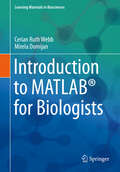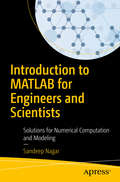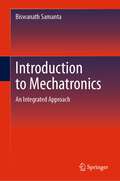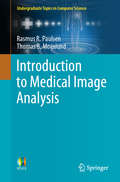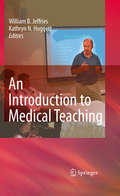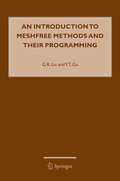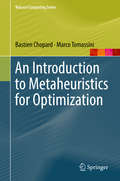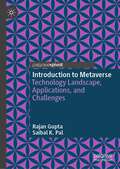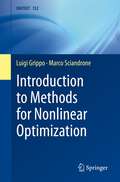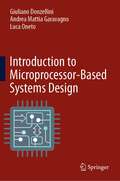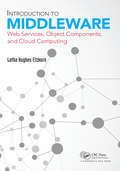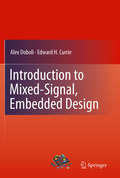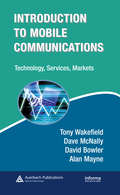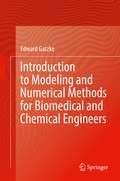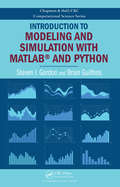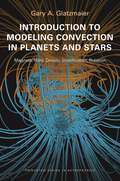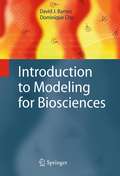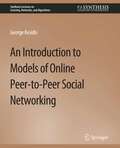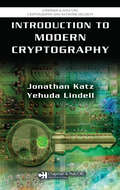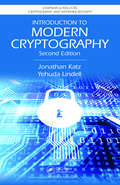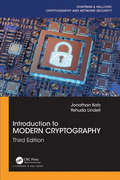- Table View
- List View
Introduction to MATLAB® for Biologists (Learning Materials in Biosciences)
by Cerian Ruth Webb Mirela DomijanThis textbook takes you from the very first time you open MATLAB® through to a position where you can comfortably integrate this computer language into your research or studies. The book will familiarise you with the MATLAB interface, show you how to use the program´s built-in functions and carefully guide you towards creating your own functions and scripts so that you can use MATLAB as a sophisticated tool to support your own research. A central aim of this book is to provide you with the core knowledge and skills required to become a confident MATLAB user so that you can find and make use of the many specialist functions and toolboxes that have been developed to support a wide range of biological applications. Examples presented within the book are selected to be relevant to biological scientists and they illustrate some of the many ways the program can be incorporated into, and used to enhance, your own research and studies. The textbook is a must-have for students and researchers in the biological sciences. It will also appeal to readers of all backgrounds who are looking for an introduction to MATLAB which is suitable for those with little or no experience of programming.
Introduction to MATLAB for Engineers and Scientists: Solutions for Numerical Computation and Modeling
by Sandeep NagarFamiliarize yourself with MATLAB using this concise, practical tutorial that is focused on writing code to learn concepts. Starting from the basics, this book covers array-based computing, plotting and working with files, numerical computation formalism, and the primary concepts of approximations. Introduction to MATLAB is useful for industry engineers, researchers, and students who are looking for open-source solutions for numerical computation.In this book you will learn by doing, avoiding technical jargon, which makes the concepts easy to learn. First you’ll see how to run basic calculations, absorbing technical complexities incrementally as you progress toward advanced topics. Throughout, the language is kept simple to ensure that readers at all levels can grasp the concepts. What You'll LearnApply sample code to your engineering or science problemsWork with MATLAB arrays, functions, and loops Use MATLAB’s plotting functions for data visualizationSolve numerical computing and computational engineering problems with a MATLAB case studyWho This Book Is ForEngineers, scientists, researchers, and students who are new to MATLAB. Some prior programming experience would be helpful but not required.
Introduction to Mechatronics: An Integrated Approach
by Biswanath SamantaThis textbook presents mechatronics through an integrated approach covering instrumentation, circuits and electronics, computer-based data acquisition and analysis, analog and digital signal processing, sensors, actuators, digital logic circuits, microcontroller programming and interfacing. The use of computer programming is emphasized throughout the text, and includes Matlab for system modeling, simulation, and analysis; LabVIEW for data acquisition and signal processing; and C++ for Arduino-based microcontroller programming and interfacing. Prof. Samanta provides numerous examples along with appropriate program codes, for simulation and analysis, that are discussed in detail to illustrate the concepts covered in each section. The book also includes the illustration of theoretical concepts through the virtual simulation platform Tinkercad to provide students virtual lab experience.
Introduction to Medical Image Analysis (Undergraduate Topics in Computer Science)
by Rasmus R. Paulsen Thomas B. MoeslundThis easy-to-follow textbook presents an engaging introduction to the fascinating world of medical image analysis. Avoiding an overly mathematical treatment, the text focuses on intuitive explanations, illustrating the key algorithms and concepts in a way which will make sense to students from a broad range of different backgrounds.Topics and features: explains what light is, and how it can be captured by a camera and converted into an image, as well as how images can be compressed and stored; describes basic image manipulation methods for understanding and improving image quality, and a useful segmentation algorithm; reviews the basic image processing methods for segmenting or enhancing certain features in an image, with a focus on morphology methods for binary images; examines how to detect, describe, and recognize objects in an image, and how the nature of color can be used for segmenting objects; introduces a statistical method to determine what class of object the pixels in an image represent; describes how to change the geometry within an image, how to align two images so that they are as similar as possible, and how to detect lines and paths in images; provides further exercises and other supplementary material at an associated website.This concise and accessible textbook will be invaluable to undergraduate students of computer science, engineering, medicine, and any multi-disciplinary courses that combine topics on health with data science. Medical practitioners working with medical imaging devices will also appreciate this easy-to-understand explanation of the technology.
An Introduction to Medical Teaching
by William B. Jeffries Kathryn N. HuggettFew faculty members in academic medical centres are formally prepared for their roles as teachers. This work is an introductory text designed to provide medical teachers with the core concepts of effective teaching practice and information about innovations for curriculum design, delivery, and assessment. It offers brief, focused chapters with content that is easily assimilated by the reader. Topics are relevant to basic science and clinical teachers, and the work does not presume readers possess prerequisite knowledge of education theory or instructional design. The authors emphasize application of concepts to teaching practice. Topics include: Helping Students Learn; Teaching Large Groups; Teaching in Small Groups; Problem Based Learning; Team-Based Learning, Teaching Clinical Skills; Teaching with Simulation; Teaching with Practicals and Labs; Teaching with Technological Tools; Designing a Course; Assessing Student Performance; Documenting the Trajectory of your Teaching and Teaching as Scholarship. Chapters were written by leaders in medical education and research who draw upon extensive professional experience and the literature on best practices in education. Although designed for teachers, the work reflects a learner-centred perspective and emphasizes outcomes for student learning. The book is accessible and visually interesting, and the work contains information that is current, but not time-sensitive. The work includes recommendations for additional reading and an appendix with resources for medical education.
An Introduction to Meshfree Methods and Their Programming
by G.R. Liu Y.T. GuThe finite difference method (FDM) hasbeen used tosolve differential equation systems for centuries. The FDM works well for problems of simple geometry and was widely used before the invention of the much more efficient, robust finite element method (FEM). FEM is now widely used in handling problems with complex geometry. Currently, we are using and developing even more powerful numerical techniques aiming to obtain more accurate approximate solutions in a more convenient manner for even more complex systems. The meshfree or meshless method is one such phenomenal development in the past decade, and is the subject of this book. There are many MFree methods proposed so far for different applications. Currently, three monographs on MFree methods have been published. Mesh Free Methods, Moving Beyond the Finite Element Method d by GR Liu (2002) provides a systematic discussion on basic theories, fundamentals for MFree methods, especially on MFree weak-form methods. It provides a comprehensive record of well-known MFree methods and the wide coverage of applications of MFree methods to problems of solids mechanics (solids, beams, plates, shells, etc.) as well as fluid mechanics. The Meshless Local Petrov-Galerkin (MLPG) Method d by Atluri and Shen (2002) provides detailed discussions of the meshfree local Petrov-Galerkin (MLPG) method and itsvariations. Formulations and applications of MLPG are well addressed in their book.
An Introduction to Metaheuristics for Optimization
by Bastien Chopard Marco TomassiniThe authors stress the relative simplicity, efficiency, flexibility of use, and suitability of various approaches used to solve difficult optimization problems. The authors are experienced, interdisciplinary lecturers and researchers and in their explanations they demonstrate many shared foundational concepts among the key methodologies. This textbook is a suitable introduction for undergraduate and graduate students, researchers, and professionals in computer science, engineering, and logistics.
Introduction to Metaverse: Technology Landscape, Applications, and Challenges
by Rajan Gupta Saibal K. PalThis book discusses Metaverse Technology, which is one of the emerging technologies around the world, through its concepts, definitions, architectural layers, economic implications, and presents comparison points with other allied areas like Web 3.0, Digital Twin, Blockchain, Multiverse, Artificial Intelligence, Internet of Everything and Hyperautomation.The book also presents several use-cases and adoption areas of Metaverse technology, along with global outlook of top companies implementing this technology through major platforms and tools. The potential use of this technology for Public Sector is also explored in this book, apart from the suggested business framework for its adoption. Potential misuse and ethical concerns have also been summarised. This introductory book on Metaverse, written with a multidisciplinary approach, will provide readers with a clear understanding of what the Metaverse is, what technologies are involved in its creation, and its current as well as potential future applications, in a very simple manner.
Introduction to Methods for Nonlinear Optimization (UNITEXT #152)
by Luigi Grippo Marco SciandroneThis book has two main objectives: • to provide a concise introduction to nonlinear optimization methods, which can be used as a textbook at a graduate or upper undergraduate level; • to collect and organize selected important topics on optimization algorithms, not easily found in textbooks, which can provide material for advanced courses or can serve as a reference text for self-study and research. The basic material on unconstrained and constrained optimization is organized into two blocks of chapters: • basic theory and optimality conditions • unconstrained and constrained algorithms. These topics are treated in short chapters that contain the most important results in theory and algorithms, in a way that, in the authors’ experience, is suitable for introductory courses. A third block of chapters addresses methods that are of increasing interest for solving difficult optimization problems. Difficulty can be typically due to the high nonlinearity of the objective function, ill-conditioning of the Hessian matrix, lack of information on first-order derivatives, the need to solve large-scale problems. In the book various key subjects are addressed, including: exact penalty functions and exact augmented Lagrangian functions, non monotone methods, decomposition algorithms, derivative free methods for nonlinear equations and optimization problems. The appendices at the end of the book offer a review of the essential mathematical background, including an introduction to convex analysis that can make part of an introductory course.
Introduction to Microprocessor-Based Systems Design
by Giuliano Donzellini Andrea Mattia Garavagno Luca OnetoThis book is intended for a first course on microprocessor-based systems design for engineering and computer science students. It starts with an introduction of the fundamental concepts, followed by a practical path that guides readers to developing a basic microprocessor example, using a step-by-step problem-solving approach. Then, a second microprocessor is presented, and readers are guided to the implementation and programming of microcomputer systems based on it. The numerous worked examples and solved exercises allow a better understanding and a more effective learning. All the examples and exercises were developed on Deeds (Digital Electronics Education and Design Suite), which is freely available online on a website developed and maintained by the authors. The discussed examples can be simulated by using Deeds and the solutions to all exercises and examples can be found on that website. Further, in the last part of this book, different microprocessor-based systems, which have been specifically thought for educational purposes, are extensively developed, simulated and implemented on FPGA-based platforms. This textbook draws on the authors’ extensive experience in teaching and developing learning materials for bachelor’s and master’s engineering courses. It can be used for self-study as well, and even independently from the simulator. Thanks to the learning-by-doing approach and the plentiful examples, no prior knowledge in computer programming is required.
Introduction to Middleware: Web Services, Object Components, and Cloud Computing
by Letha Hughes Etzkorn"A stereotype of computer science textbooks is that they are dry, boring, and sometimes even intimidating. As a result, they turn students’ interests off from the subject matter instead of enticing them into it. This textbook is the opposite of such a stereotype. The author presents the subject matter in a refreshing story-telling style and aims to bring the Internet-generation of students closer to her stories." --Yingcai Xiao, The University of Akron Introduction to Middleware: Web Services, Object Components, and Cloud Computing provides a comparison of different middleware technologies and the overarching middleware concepts they are based on. The various major paradigms of middleware are introduced and their pros and cons are discussed. This includes modern cloud interfaces, including the utility of Service Oriented Architectures. The text discusses pros and cons of RESTful vs. non-RESTful web services, and also compares these to older but still heavily used distributed object/component middleware. The text guides readers to select an appropriate middleware technology to use for any given task, and to learn new middleware technologies as they appear over time without being greatly overwhelmed by any new concept. The book begins with an introduction to different distributed computing paradigms, and a review of the different kinds of architectures, architectural styles/patterns, and properties that various researchers have used in the past to examine distributed applications and determine the quality of distributed applications. Then it includes appropriate background material in networking and the web, security, and encoding necessary to understand detailed discussion in this area. The major middleware paradigms are compared, and a comparison methodology is developed. Readers will learn how to select a paradigm and technology for a particular task, after reading this text. Detailed middleware technology review sections allow students or industry practitioners working to expand their knowledge to achieve practical skills based on real projects so as to become well-functional in that technology in industry. Major technologies examined include: RESTful web services (RESTful cloud interfaces such as OpenStack, AWS EC2 interface, CloudStack; AJAX, JAX-RS, ASP.NET MVC and ASP.NET Core), non-RESTful (SOAP and WSDL-based) web services (JAX-WS, Windows Communication Foundation), distributed objects/ components (Enterprise Java Beans, .NET Remoting, CORBA). The book presents two projects that can be used to illustrate the practical use of middleware, and provides implementations of these projects over different technologies. This versatile and class-tested textbook is suitable (depending on chapters selected) for undergraduate or first-year graduate courses on client server architectures, middleware, and cloud computing, web services, and web programming.
Introduction to Middleware: Web Services, Object Components, and Cloud Computing
by Letha Hughes Etzkorn"A stereotype of computer science textbooks is that they are dry, boring, and sometimes even intimidating. As a result, they turn students’ interests off from the subject matter instead of enticing them into it. This textbook is the opposite of such a stereotype. The author presents the subject matter in a refreshing story-telling style and aims to bring the Internet-generation of students closer to her stories." --Yingcai Xiao, The University of Akron Introduction to Middleware: Web Services, Object Components, and Cloud Computing provides a comparison of different middleware technologies and the overarching middleware concepts they are based on. The various major paradigms of middleware are introduced and their pros and cons are discussed. This includes modern cloud interfaces, including the utility of Service Oriented Architectures. The text discusses pros and cons of RESTful vs. non-RESTful web services, and also compares these to older but still heavily used distributed object/component middleware. The text guides readers to select an appropriate middleware technology to use for any given task, and to learn new middleware technologies as they appear over time without being greatly overwhelmed by any new concept. The book begins with an introduction to different distributed computing paradigms, and a review of the different kinds of architectures, architectural styles/patterns, and properties that various researchers have used in the past to examine distributed applications and determine the quality of distributed applications. Then it includes appropriate background material in networking and the web, security, and encoding necessary to understand detailed discussion in this area. The major middleware paradigms are compared, and a comparison methodology is developed. Readers will learn how to select a paradigm and technology for a particular task, after reading this text. Detailed middleware technology review sections allow students or industry practitioners working to expand their knowledge to achieve practical skills based on real projects so as to become well-functional in that technology in industry. Major technologies examined include: RESTful web services (RESTful cloud interfaces such as OpenStack, AWS EC2 interface, CloudStack; AJAX, JAX-RS, ASP.NET MVC and ASP.NET Core), non-RESTful (SOAP and WSDL-based) web services (JAX-WS, Windows Communication Foundation), distributed objects/ components (Enterprise Java Beans, .NET Remoting, CORBA). The book presents two projects that can be used to illustrate the practical use of middleware, and provides implementations of these projects over different technologies. This versatile and class-tested textbook is suitable (depending on chapters selected) for undergraduate or first-year graduate courses on client server architectures, middleware, and cloud computing, web services, and web programming.
Introduction to Mixed-Signal, Embedded Design
by Alex Doboli Edward H. CurrieThis textbook is written for junior/senior undergraduate and first-year graduate students in the electrical and computer engineering departments. Using PSoC mixed-signal array design, the authors define the characteristics of embedd design, embedded mixed-signal architectures, and top-down design. Optimized implementations of these designs are included to illustrate the theory. Exercises are provided at the end of each chapter for practice. Topics covered include the hardware and software used to implement analog and digital interfaces, various filter structures, amplifiers and other signal-conditioning circuits, pulse-width modulators, timers, and data structures for handling multiple similar peripheral devices. The practical exercises contained in the companion laboratory manual, which was co-authored by Cypress Staff Applications Engineer Dave Van Ess, are also based on PSoC. PSoC's integrated microcontroller, highly configurable analog/digital peripherals, and a full set of development tools make it an ideal learning tool for developing mixed-signal embedded design skills.
Introduction to Mobile Communications: Technology, Services, Markets
by Tony Wakefield Dave McNally David Bowler Alan MayneThe traditionally separate Fixed, Mobile, and Internet sectors have been evolving recently toward a single sector, offering numerous implications for those involved in technology and business. It is therefore essential for telecommunication professionals to get a keen grasp of where the industry is heading. Providing a solid foundation in the industry, Introduction to Mobile Communications: Technology, Services, Markets explores the core requirements of modern mobile telecommunications-from markets to technology. It explains how wireless systems work, how mobility is supported, the underlying infrastructure, and what interactions are needed among the different functional components. The book also examines how mobile communications are evolving in order to meet the changing needs of users. The information provided in the book comes primarily from the four core modules of the Certificate in Mobile Communications Distance Learning program run by the Informa Telecoms Academy in London. Designed by a highly experienced training development team, the program examines the complex and fascinating world of mobile communications. Designed to give a broad picture of mobile communications, the book provides an excellent grounding for those involved in both business and engineering-leaving them much better equipped to fulfill roles within their current or prospective companies
Introduction to Modeling and Numerical Methods for Biomedical and Chemical Engineers
by Edward GatzkeThis textbook introduces the concepts and tools that biomedical and chemical engineering students need to know in order to translate engineering problems into a numerical representation using scientific fundamentals. Modeling concepts focus on problems that are directly related to biomedical and chemical engineering. A variety of computational tools are presented, including MATLAB, Excel, Mathcad, and COMSOL, and a brief introduction to each tool is accompanied by multiple computer lab experiences. The numerical methods covered are basic linear algebra and basic statistics, and traditional methods like Newton’s method, Euler Integration, and trapezoidal integration. The book presents the reader with numerous examples and worked problems, and practice problems are included at the end of each chapter.
Introduction to Modeling and Simulation with MATLAB® and Python (Chapman & Hall/CRC Computational Science)
by Steven I. Gordon Brian GuilfoosIntroduction to Modeling and Simulation with MATLAB and Python is intended for students and professionals in science, social science, and engineering that wish to learn the principles of computer modeling, as well as basic programming skills. The book content focuses on meeting a set of basic modeling and simulation competencies that were developed as part of several National Science Foundation grants. Even though computer science students are much more expert programmers, they are not often given the opportunity to see how those skills are being applied to solve complex science and engineering problems and may also not be aware of the libraries used by scientists to create those models. The book interleaves chapters on modeling concepts and related exercises with programming concepts and exercises. The authors start with an introduction to modeling and its importance to current practices in the sciences and engineering. They introduce each of the programming environments and the syntax used to represent variables and compute mathematical equations and functions. As students gain more programming expertise, the authors return to modeling concepts, providing starting code for a variety of exercises where students add additional code to solve the problem and provide an analysis of the outcomes. In this way, the book builds both modeling and programming expertise with a "just-in-time" approach so that by the end of the book, students can take on relatively simple modeling example on their own. Each chapter is supplemented with references to additional reading, tutorials, and exercises that guide students to additional help and allows them to practice both their programming and analytical modeling skills. In addition, each of the programming related chapters is divided into two parts – one for MATLAB and one for Python. In these chapters, the authors also refer to additional online tutorials that students can use if they are having difficulty with any of the topics. The book culminates with a set of final project exercise suggestions that incorporate both the modeling and programming skills provided in the rest of the volume. Those projects could be undertaken by individuals or small groups of students. The companion website at http://www.intromodeling.com provides updates to instructions when there are substantial changes in software versions, as well as electronic copies of exercises and the related code. The website also offers a space where people can suggest additional projects they are willing to share as well as comments on the existing projects and exercises throughout the book. Solutions and lecture notes will also be available for qualifying instructors.
Introduction to Modeling and Simulation with MATLAB® and Python (Chapman & Hall/CRC Computational Science)
by Steven I. Gordon Brian GuilfoosIntroduction to Modeling and Simulation with MATLAB and Python is intended for students and professionals in science, social science, and engineering that wish to learn the principles of computer modeling, as well as basic programming skills. The book content focuses on meeting a set of basic modeling and simulation competencies that were developed as part of several National Science Foundation grants. Even though computer science students are much more expert programmers, they are not often given the opportunity to see how those skills are being applied to solve complex science and engineering problems and may also not be aware of the libraries used by scientists to create those models. The book interleaves chapters on modeling concepts and related exercises with programming concepts and exercises. The authors start with an introduction to modeling and its importance to current practices in the sciences and engineering. They introduce each of the programming environments and the syntax used to represent variables and compute mathematical equations and functions. As students gain more programming expertise, the authors return to modeling concepts, providing starting code for a variety of exercises where students add additional code to solve the problem and provide an analysis of the outcomes. In this way, the book builds both modeling and programming expertise with a "just-in-time" approach so that by the end of the book, students can take on relatively simple modeling example on their own. Each chapter is supplemented with references to additional reading, tutorials, and exercises that guide students to additional help and allows them to practice both their programming and analytical modeling skills. In addition, each of the programming related chapters is divided into two parts – one for MATLAB and one for Python. In these chapters, the authors also refer to additional online tutorials that students can use if they are having difficulty with any of the topics. The book culminates with a set of final project exercise suggestions that incorporate both the modeling and programming skills provided in the rest of the volume. Those projects could be undertaken by individuals or small groups of students. The companion website at http://www.intromodeling.com provides updates to instructions when there are substantial changes in software versions, as well as electronic copies of exercises and the related code. The website also offers a space where people can suggest additional projects they are willing to share as well as comments on the existing projects and exercises throughout the book. Solutions and lecture notes will also be available for qualifying instructors.
Introduction to Modeling Convection in Planets and Stars: Magnetic Field, Density Stratification, Rotation
by Gary A. GlatzmaierThis book provides readers with the skills they need to write computer codes that simulate convection, internal gravity waves, and magnetic field generation in the interiors and atmospheres of rotating planets and stars. Using a teaching method perfected in the classroom, Gary Glatzmaier begins by offering a step-by-step guide on how to design codes for simulating nonlinear time-dependent thermal convection in a two-dimensional box using Fourier expansions in the horizontal direction and finite differences in the vertical direction. He then describes how to implement more efficient and accurate numerical methods and more realistic geometries in two and three dimensions. In the third part of the book, Glatzmaier demonstrates how to incorporate more sophisticated physics, including the effects of magnetic field, density stratification, and rotation. Featuring numerous exercises throughout, this is an ideal textbook for students and an essential resource for researchers. Describes how to create codes that simulate the internal dynamics of planets and stars Builds on basic concepts and simple methods Shows how to improve the efficiency and accuracy of the numerical methods Describes more relevant geometries and boundary conditions Demonstrates how to incorporate more sophisticated physics
Introduction to Modeling Convection in Planets and Stars: Magnetic Field, Density Stratification, Rotation
by Gary A. GlatzmaierThis book provides readers with the skills they need to write computer codes that simulate convection, internal gravity waves, and magnetic field generation in the interiors and atmospheres of rotating planets and stars. Using a teaching method perfected in the classroom, Gary Glatzmaier begins by offering a step-by-step guide on how to design codes for simulating nonlinear time-dependent thermal convection in a two-dimensional box using Fourier expansions in the horizontal direction and finite differences in the vertical direction. He then describes how to implement more efficient and accurate numerical methods and more realistic geometries in two and three dimensions. In the third part of the book, Glatzmaier demonstrates how to incorporate more sophisticated physics, including the effects of magnetic field, density stratification, and rotation. Featuring numerous exercises throughout, this is an ideal textbook for students and an essential resource for researchers. Describes how to create codes that simulate the internal dynamics of planets and stars Builds on basic concepts and simple methods Shows how to improve the efficiency and accuracy of the numerical methods Describes more relevant geometries and boundary conditions Demonstrates how to incorporate more sophisticated physics
Introduction to Modeling for Biosciences
by David J. Barnes Dominique ChuMathematical modeling can be a useful tool for researchers in the biological scientists. Yet in biological modeling there is no one modeling technique that is suitable for all problems. Instead, different problems call for different approaches. Furthermore, it can be helpful to analyze the same system using a variety of approaches, to be able to exploit the advantages and drawbacks of each. In practice, it is often unclear which modeling approaches will be most suitable for a particular biological question, a problem which requires researchers to know a reasonable amount about a number of techniques, rather than become experts on a single one. "Introduction to Modeling for Biosciences" addresses this issue by presenting a broad overview of the most important techniques used to model biological systems. In addition to providing an introduction into the use of a wide range of software tools and modeling environments, this helpful text/reference describes the constraints and difficulties that each modeling technique presents in practice, enabling the researcher to quickly determine which software package would be most useful for their particular problem. Topics and features: introduces a basic array of techniques to formulate models of biological systems, and to solve them; intersperses the text with exercises throughout the book; includes practical introductions to the Maxima computer algebra system, the PRISM model checker, and the Repast Simphony agent modeling environment; discusses agent-based models, stochastic modeling techniques, differential equations and Gillespie’s stochastic simulation algorithm; contains appendices on Repast batch running, rules of differentiation and integration, Maxima and PRISM notation, and some additional mathematical concepts; supplies source code for many of the example models discussed, at the associated website http://www.cs.kent.ac.uk/imb/. This unique and practical guide leads the novice modeler through realistic and concrete modeling projects, highlighting and commenting on the process of abstracting the real system into a model. Students and active researchers in the biosciences will also benefit from the discussions of the high-quality, tried-and-tested modeling tools described in the book. Dr. David J. Barnes is a lecturer in computer science at the University of Kent, UK, with a strong background in the teaching of programming. Dr. Dominique Chu is a lecturer in computer science at the University of Kent, UK. He is an internationally recognized expert in agent-based modeling, and has also in-depth research experience in stochastic and differential equation based modeling.
An Introduction to Models of Online Peer-to-Peer Social Networking (Synthesis Lectures on Learning, Networks, and Algorithms)
by George KesidisThis book concerns peer-to-peer applications and mechanisms operating on the Internet, particularly those that are not fully automated and involve significant human interaction. So, the realm of interest is the intersection of distributed systems and online social networking. Generally, simple models are described to clarify the ideas. Beginning with short overviews of caching, graph theory and game theory, we cover the basic ideas of structured and unstructured search. We then describe a simple framework for reputations and for iterated referrals and consensus. This framework is applied to a problem of sybil identity management. The fundamental result for iterated Byzantine consensus for a relatively important issue is also given. Finally, a straight-forward epidemic model is used to describe the propagation of malware on-line and for BitTorrent-style file-sharing. This short book can be used as a preliminary orientation to this subject matter. References are given for the interested student to papers with good survey and tutorial content and to those with more advanced treatments of specific topics. For an instructor, this book is suitable for a one-semester seminar course. Alternatively, it could be the framework for a semester's worth of lectures where the instructor would supplement each chapter with additional lectures on related or more advanced subject matter. A basic background is required in the areas of computer networking, probability theory, stochastic processes, and queueing. Table of Contents: Networking overview / Graphs / Games / Search in structured networks / Search in unstructured networks / Transactions, reputations, and referrals / False Referrals / Peer-to-peer file sharing / Consensus in dynamical belief systems / Byzantine consensus / Epidemics
Introduction to Modern Cryptography: Principles and Protocols
by Jonathan KatzCryptography plays a key role in ensuring the privacy and integrity of data and the security of computer networks. Introduction to Modern Cryptography provides a rigorous yet accessible treatment of modern cryptography, with a focus on formal definitions, precise assumptions, and rigorous proofs.The authors introduce the core principles of
Introduction to Modern Cryptography (Chapman And Hall/crc Cryptography And Network Security Ser.)
by Jonathan Katz Yehuda LindellCryptography is ubiquitous and plays a key role in ensuring data secrecy and integrity as well as in securing computer systems more broadly. Introduction to Modern Cryptography provides a rigorous yet accessible treatment of this fascinating subject. The authors introduce the core principles of modern cryptography, with an emphasis on formal defini
Introduction to Modern Cryptography (Chapman & Hall/CRC Cryptography and Network Security Series)
by Jonathan Katz Yehuda LindellNow the most used texbook for introductory cryptography courses in both mathematics and computer science, the Third Edition builds upon previous editions by offering several new sections, topics, and exercises. The authors present the core principles of modern cryptography, with emphasis on formal definitions, rigorous proofs of security.
Introduction to Modern Cryptography (Chapman & Hall/CRC Cryptography and Network Security Series)
by Jonathan Katz Yehuda LindellNow the most used texbook for introductory cryptography courses in both mathematics and computer science, the Third Edition builds upon previous editions by offering several new sections, topics, and exercises. The authors present the core principles of modern cryptography, with emphasis on formal definitions, rigorous proofs of security.
